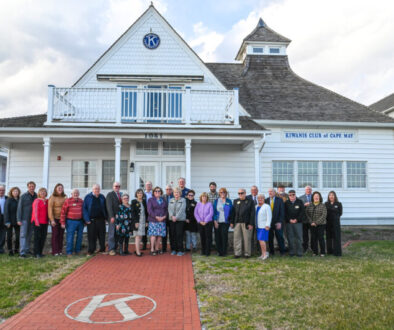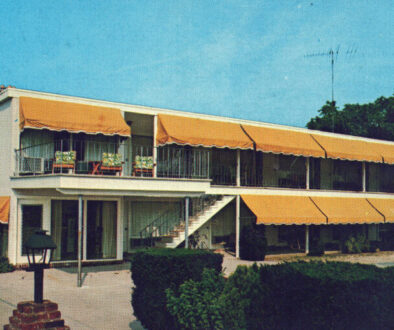The Inn of Cape May
Something claiming to be the anything of anywhere must be sure to live up to the title—which is certainly the case for the Inn of Cape May. The property at 7 Ocean Street is an exemplary sample of both the Victorian architecture and hotel design in Cape May during the late 19th century. In fact, the New Jersey State Historic Preservation Office has identified the Inn of Cape May as one of the last remaining resort hotels of its kind. The designation is warranted. While most similar large-scale timber-framed hotels fell victim to fire or natural disaster, the Inn of Cape May has endured.
Even so, its kind may be hard to pin down, as the building that exists today has evolved significantly over time. Originally developed by the local Church Brothers as the Colonial Hotel, constructed between 1894 and 1895, the Inn of Cape May is one of this historic seaside town’s most iconic structures—and stands out among many of those facing the ocean along Beach Avenue. However, the now-illustrious building began as a modest rectangular cottage-style boarding house, with the main entrance in the same location that exists today and a central hall with rooms on either side.

Back then, the trademark porch was notably different, stretching along the entire southern elevation, parallel to the beach. Quickly though, by 1905, the hotel effectively doubled in size with the construction of the wing projecting south. Within 15 years of breaking ground on the initial build, a 1909 Sanborn map indicates (more or less) the same building volume we would see today.
Given the size of the hotel—said to have been the tallest building on the coast at the time of construction—management had to ensure the provision of expeditious service for their guests. This called for the installation of Cape May’s first elevator, which is still in operation today.
As it currently exists, the building is five stories tall at its highest point and covers almost the entire northern half of the property. Its L-shaped plan wraps around a large front lawn, like other notable hotels in Cape May of similar age. This open space on the southern half of the property, at the intersection of Ocean and Beach, allows for guest rooms to take advantage of sweeping, postcard-worthy views of the Atlantic Ocean. Though it is likely to have originally accommodated more leisurely activities reserved for gentlemen, the south lawn now features a more family-friendly swimming pool for guests of both the Inn of Cape May and the neighboring Avondale by the Sea.
The Inn of Cape May is colloquially identified as an example of Victorian architecture, but it can be more specifically categorized as Second Empire—known for its combination of design features from various periods and styles. The hotel’s main entrance is emphasized by two large towers, one on each corner of the wing projecting toward Ocean Street. The towers are hexagonal in plan and terminate with spire roofs clad in diamond-shaped shingles.
The building’s primary roof shape is a concave mansard, which encloses the entire fourth floor. Its curved face is sided with scalloped wood shingles, and the top is covered with a shallow standing seam metal roofing. A fifth story volume extends above that, at the corner of the L-configuration, and the hotel tops out with a windowless cupola. The rooflines of the Inn are likely to grab the attention of even the casual observer, with steeply pitched gables and decorative dormers. Some may think those dormers were implemented simply for aesthetics. That’s not the case. Not only do they add visual interest, but they also serve a practical purpose, providing ventilation and natural light to the upper floors of the building.


Large windows are another characteristic feature of Victorian architecture, and the Inn of Cape May is no exception. All the windows at the Inn are two-over-two, wood sash windows—except for those at the top of each tower, which are one-of-one. The windows are tall and narrow, with decorative moldings and muntins, allowing ample light to flood the interior spaces.
The hotel’s exterior reflects the Victorian penchant for contrast of both color and texture. The façade displays a rhythm of alternating bands in horizontal clapboard siding and scalloped wood shingles. The use of a soft pastel paint color on all the siding ensures that the rather large building does not come off as having an overwhelming or offensive presence on such a prominent beachfront corner. Its subtle contrast with surrounding trim pieces painted white is enough to catch the eye. For good measure, darker tones accentuate the intricate details of the architecture – including porch columns, molded top and bottom rails, and curved brackets. One of the defining features of the Victorian era is its emphasis on decorative elements. Elaborate trim work, including brackets, spindles, and friezes, adorn the exterior, adding depth and texture to the facade. Intricate woodwork, such as the lacy patterns of the balconies and the detailed carvings around the windows and doors, showcase the craftsmanship of the period.
The Inn’s prominent feature is its expansive wrap-around porch. It’s covered with a standing seam metal roof, framed to display carved rafter tails at the roof edge. The structure is supported by elegant turned posts over brick piers, and it’s adorned with elaborate gingerbread trim, a hallmark of Victorian design. Referred to fondly as The Porch, the outdoor space is used for a variety of activities and functions. It could be visitors simply sitting and waiting while a family member checks in or out, a guest having an early morning coffee, or a group of friends having cocktails during a local musician’s set. The porch offers not only a place to relax and enjoy the sea breeze but also serves as a social hub, where guests can gather and enjoy each other’s company.
The Inn entered the 21st century retaining its status not only as a key contributing building in Cape May City’s Historic District, but as a historic landmark on both the New Jersey and National Register of Historic Places due to its high level of architectural integrity. Architectural enthusiasts can rest assured knowing its historic hotel’s character has been maintained (perhaps enhanced) through the most recent renovation, managed by Cape May Contracting, which concluded in 2022.
Overall, the Inn of Cape May is a stunning example of Victorian architecture, showcasing the elegance and grandeur of the era. Its ornate design and intricate detailing make it a true gem of Cape May and a testament to the enduring beauty of Victorian design.



